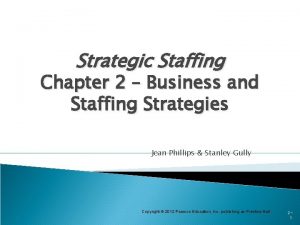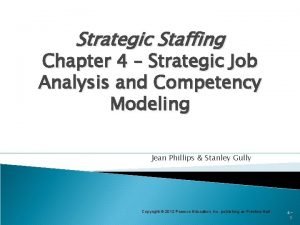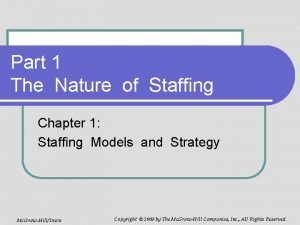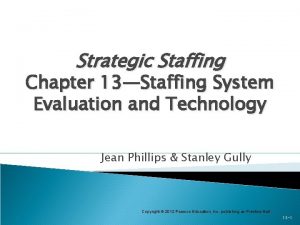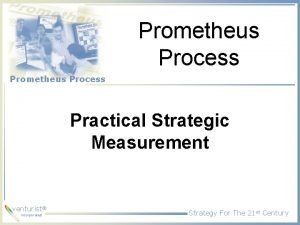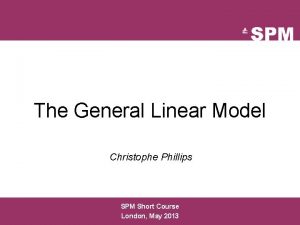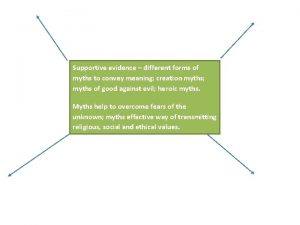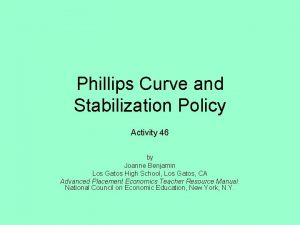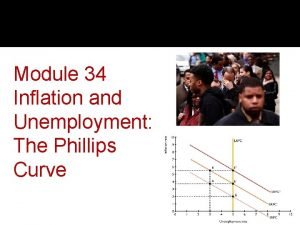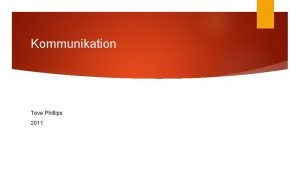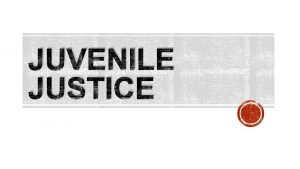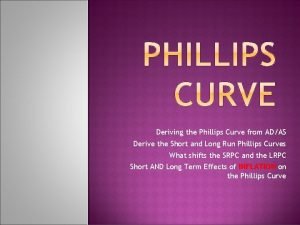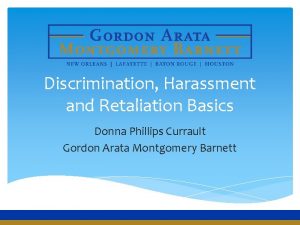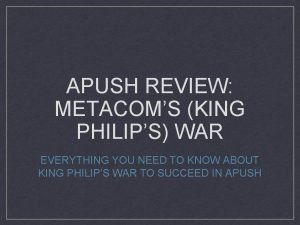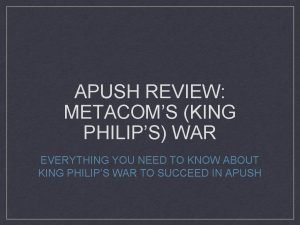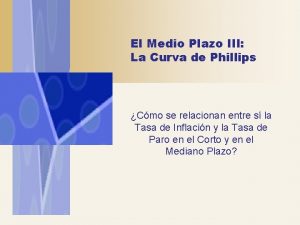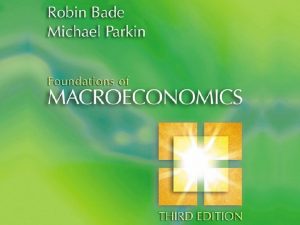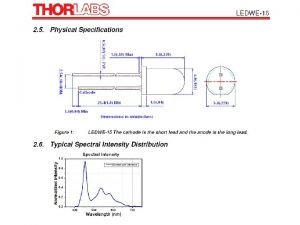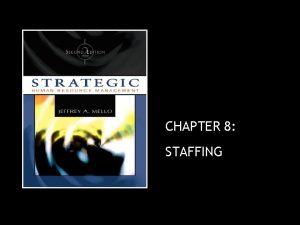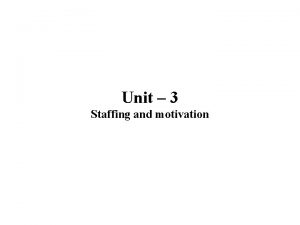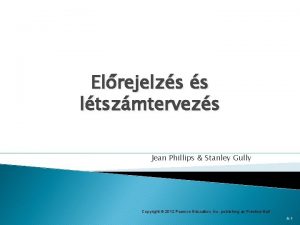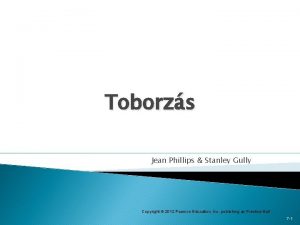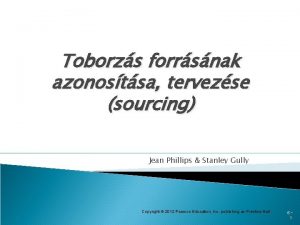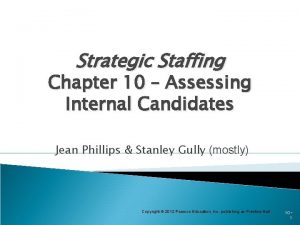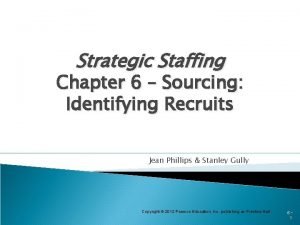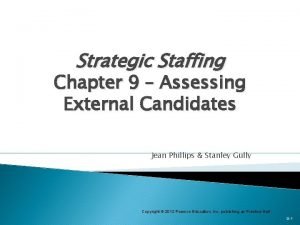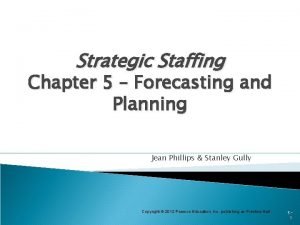Strategic Staffing Chapter 8 Measurement Jean Phillips Stanley





























































- Slides: 61

Strategic Staffing Chapter 8 – Measurement Jean Phillips & Stanley Gully Copyright © 2012 Pearson Education, Inc. publishing as Prentice Hall 81

Why Is Proper Measurement Important? Effective measurement and data analytics can result in a competitive edge Improperly assessing and measuring candidate characteristics can lead to: ◦ Systematically hiring the wrong people ◦ Offending and losing good candidates ◦ Exposing your company to legal action There are many legal issues involved with candidate assessment and measurement Copyright © 2012 Pearson Education, Inc. publishing as Prentice Hall 82

What Is Measurement? Measurement is the process of assigning numbers according to some rule or convention to aspects of people, jobs, job success, or aspects of the staffing system The measures enables improvement of the staffing system by identifying patterns useful for understanding and predicting relevant processes and outcomes The measures relevant to staffing are those that assess: ◦ The characteristics of the job, which enables the creation of job requirements and job rewards matrices ◦ Aspects of the staffing system such as the number of days a job posting is run, where it is run, and the recruiting message ◦ The characteristics of job candidates such as ability or personality ◦ Staffing outcomes, such as performance or turnover Copyright © 2012 Pearson Education, Inc. publishing as Prentice Hall 83

What Is Data? ◦ ◦ The numerical outcomes of measurement are data There are 2 types of data: Predictive data is information about measures used to make projections about outcomes. Criterion data is information about important outcomes of the staffing process. Traditionally, this data includes measurement of employee job success, which is the organization’s unique definition of success and performance in the job and in the firm. Criterion data should also include all outcome data that is relevant to the evaluation of the effectiveness of the staffing system against its goals. This may include measures of job success, time-to-hire, promotion rates, and tenure rates as well as job and company engagement, fit with company values, and willingness to help other employees. Copyright © 2012 Pearson Education, Inc. publishing as Prentice Hall 84

Types of Measurement Nominal: numbers are assigned to discrete labels or categories (e. g. , race, gender, college major) Ordinal: attributes are ranked in ascending or descending order (e. g. , ranking from best to worst performance) Interval: zero point is arbitrary but distance between scores has meaning (e. g. , intelligence or interview scores) Ratio: distance between scores has meaning and there is a true zero point (e. g. , salary, typing speed) Copyright © 2012 Pearson Education, Inc. publishing as Prentice Hall 85

Describing Data Scoring: The process of assigning numerical values during measurement Raw scores: the unadjusted scores on a measure ◦ Criterion-referenced measures: measures in which the scores have meaning in and of themselves ◦ Norm-referenced measures: measures in which the scores have meaning only in comparison to the scores of other respondents Normal curve: a symmetrical, bell-shaped curve representing the distribution of a characteristic Copyright © 2012 Pearson Education, Inc. publishing as Prentice Hall 86

The Normal Curve Copyright © 2012 Pearson Education, Inc. publishing as Prentice Hall 87

Describing the Normal Curve Percentile score: a raw score that has been converted into an expression of the percentage of people whose score falls at or below that score Central tendency: describes the midpoint or center of data ◦ Mean: the average of the scores ◦ Median: the middle score , or the point below which 50 percent of the scores fall ◦ Mode: the most commonly observed score (bimodal = two modes) Variability: describes the spread of the data around the midpoint ◦ Range: the difference between the highest &lowest observed score ◦ Outlier: score much higher or lower than most of the scores in a distribution ◦ Variance: a mathematical measure of spread based on squared deviations of scores from the mean ◦ Standard deviation: positive square root of the variance; conceptually similar to the average distance from the mean of a set of scores Copyright © 2012 Pearson Education, Inc. publishing as Prentice Hall 88

Standard Scores Standard scores: converted raw scores that indicate where a person’s score lies in comparison to a referent group ◦ Indicates how many units of standard deviations the individual’s score is above or below the mean of the referent group A standard score is negative when the target individual’s raw score is below the referent group’s mean, and positive when the target individual’s raw score is above the referent group’s mean Copyright © 2012 Pearson Education, Inc. publishing as Prentice Hall 8 -9

Converting Raw Scores to Standard Scores zscore = (individual’s raw score – referent group mean) / referent group standard deviation) Meaningfully combining the raw scores would be difficult. Combining the z scores is easy and results in a single number reflecting how each candidate did on both of the assessments relative to the other candidates. Copyright © 2012 Pearson Education, Inc. publishing as Prentice Hall 8 -10

Shifting the Normal Applicant Talent Curve When making candidate selection decisions, it is often assumed that in the applicant pool, the distribution of applicant fit with the job reflects the normal curve. A large burden is then placed on the selection system to accurately identify which candidates are in the far right tail of the normal curve. However, many of the most desirable people for the position are likely to be actively and happily employed elsewhere and are semi-passive job seekers at best. In this case, the distribution of applicant fit with the job might resemble the A distribution shown on the next slide. Copyright © 2012 Pearson Education, Inc. publishing as Prentice Hall 8 -11

Shifting the Applicant Talent Curve Copyright © 2012 Pearson Education, Inc. publishing as Prentice Hall 8 -12

Shifting the Normal Applicant Talent Curve If done strategically, sourcing and recruiting can discourage poor fits from applying and increase the number of high quality passive and semi-passive candidates who apply. This shifts the curve to reflect a distribution like that shown by the B distribution. The B distribution clearly reduces the burden on the selection system to identify quality candidates and significantly increases the likelihood of identifying a high-quality candidate. Copyright © 2012 Pearson Education, Inc. publishing as Prentice Hall 8 -13

(Linear) Correlation Coefficient Linear correlation coefficient, also called “Pearson’s r” or the “bivariate correlation, ” is a single number that ranges from -1 to +1 that reflects the direction (positive or negative) and magnitude (strength) of the relationship between two variables. ◦ A value of r = 0 indicates that values of one measure are not linearly related to values of the other measure (but they are not neceassarily independent). ◦ A value of r = +1 means that there is a perfectly linear, positive relationship between the two measures; as values of one measure increase, values of the other measure increase exactly the same amount in standard deviations. ◦ A value of r = -1 means that there is a perfectly negative or inverse relationship between the two measures; as values of one measure increase, values of the other variable decrease exactly the same amount in standard deviations. Copyright © 2012 Pearson Education, Inc. publishing as Prentice Hall 8 -14

Graphing Correlations Scatter plot: graphical illustration of the relationship between two variables ◦ Each point on the chart corresponds to how a person scored on a measure and how he or she performed on the job Copyright © 2012 Pearson Education, Inc. publishing as Prentice Hall 8 -15

Scatter Plot of r = -. 43 Would this test be useful in making hiring decisions? Copyright © 2012 Pearson Education, Inc. publishing as Prentice Hall 8 -16

Scatter Plot of a Curvilinear Relationship (r =. 04) Copyright © 2012 Pearson Education, Inc. publishing as Prentice Hall 8 -17

Example Uses of Correlation Coefficients Relating store size with staffing levels Relating seniority in a firm with job performance Relating the time to fill a job with new-hire quality Relating quality of new hires with business performance and customer satisfaction Copyright © 2012 Pearson Education, Inc. publishing as Prentice Hall 8 -18

Interpreting Correlations Sampling error: When you use statistics, including correlations, to draw inferences or conclusions, you have to be concerned about sampling error. Sampling error is the variability in sample correlations due to chance. You can address sampling error through statistical significance testing procedures. Copyright © 2012 Pearson Education, Inc. publishing as Prentice Hall 8 -19

Interpreting Correlations Statistical significance: the degree to which the observed relationship is not likely due to sampling error. ◦ This is a minimum requirement for establishing a meaningful relationship Practical significance: the observed relationship is large enough to be of value in a practical sense. ◦ In a large enough sample, a very small correlation would be statistically significant but the relationship may not be strong enough to justify the expense and time of using the predictor An inexpensive assessment system may be useful even if the correlation is small. Alternatively, if an assessment method that correlated. 15 with job success was expensive, took a long time to administer, and was only moderately liked by job candidates, it may not be worth using even if it is a statistically significant predictor of job success. Copyright © 2012 Pearson Education, Inc. publishing as Prentice Hall 8 -20

Multiple Regression A statistical technique that predicts an outcome using one or more predictor variables; it identifies the ideal weights to assign each predictor to maximize the validity of a set of predictors; the analysis is based on each predictor’s correlation with the outcome and the degree to which the predictors are themselves intercorrelated Multiple regression examines the effect of each predictor variable after statistically controlling for the effects of other predictors in the equation Copyright © 2012 Pearson Education, Inc. publishing as Prentice Hall 8 -21

Example Multiple Regression Equation Job successpredicted = Constant + (b 1*Test score 1) + (b 2 * Test score 2) Job successpredicted + (b 3 * Test score 3)… = 10 + (2 * Interview) + (1 * Personality) + (. 2 * Job knowledge) If someone scores 50 on the interview, 27 on the personality test, and 20 on the job knowledge test, what is the predicted job success score? Job successpredicted = 10 + (2 * 50) + (1 * 27) + (. 2 * 20) Job successpredicted = 141 is then compared with predicted job success scores of other candidates to determine who should be selected Copyright © 2012 Pearson Education, Inc. publishing as Prentice Hall 822

What Is Reliability? Reliability refers to how dependably or consistently a measure assesses a particular characteristic Measurement error influences reliability. Measurement error can be random or systematic. To evaluate a measure’s reliability, you should consider: ◦ The type of measure ◦ The type of reliability estimate reported ◦ The context in which the measure will be used Copyright © 2012 Pearson Education, Inc. publishing as Prentice Hall 8 -23

Reasons for Differing Scores on a Test or Assessment All of these factors, as well as others, can influence reliability. That is why tests or assessment tools should be standardized in their use. ◦ ◦ Temporary physical or psychological state Environmental factors Version, or form, of the measure Different evaluators Copyright © 2012 Pearson Education, Inc. publishing as Prentice Hall 8 -24

Types of Errors Random error: error that is not due to any Systematic error: error that occurs because consistent cause of consistent and predictable factors Deficiency error: error that occurs when you fail to measure important aspects of the attribute you would like to measure Contamination error: error that occurs when other factors unrelated to whatever is being assessed affect the observed scores Copyright © 2012 Pearson Education, Inc. publishing as Prentice Hall 8 -25

Interpreting Reliability Coefficients Copyright © 2012 Pearson Education, Inc. publishing as Prentice Hall 8 -26

Types of Reliability Test-retest reliability reflects the repeatability of scores over time and the stability of the underlying construct being measured Alternate or parallel form reliability indicates how consistent scores are likely to be if a person completes two or more forms of the same measure Internal consistency reliability indicates the extent to which items on a given measure assess the same construct Inter-rater reliability indicates how consistent scores are likely to be if the responses are scored by two or more raters using the same item, scale, or instrument Copyright © 2012 Pearson Education, Inc. publishing as Prentice Hall 8 -27

Cronbach's alpha Commonly used as a measure of the internal consistency of psychometric tests. Not robust against missing data. k : the number of items sample variance for item i sample variance of the total test scores Copyright © 2011 Pearson Education, Inc. Publishing as Prentice Hall 128

Standard Error of Measurement The standard error of measurement (SEM) is the margin of error that you should expect in an individual score because of the imperfect reliability of the measure. It represents the spread of scores you might have observed had you tested the same person repeatedly. The confidence interval represents the degree of confidence that a person’s “true” score lies within their earned score plus or minus the SEM, given some level of desired confidence. The lower the standard error, the more accurate the measurements. ◦ If the SEM is 0, then each observed score is that person’s true score Copyright © 2012 Pearson Education, Inc. publishing as Prentice Hall 8 -29

Standard Error of Measurement SEM = s. X(1 -rxx)0, 5 Copyright © 2011 Pearson Education, Inc. Publishing as Prentice Hall 130

What Is Validity? Validity refers to how well a measure assesses a given construct and the degree to which you can make specific conclusions or predictions based on observed scores. Validity can tell you what you may conclude or predict about someone based on his or her score on a measure, thus indicating the measure’s usefulness. Validity will tell you how useful a measure is for a particular situation; reliability will tell you how consistent scores from that measure will be. You cannot draw valid conclusions unless you are sure that the measure is reliable. Even when a measure is reliable, it may not be valid. ◦ You might be able to measure a person’s shoe size reliably but it may not be useful as a predictor of job performance. Any measure used in staffing needs to be both reliable and valid for the situation. Copyright © 2012 Pearson Education, Inc. publishing as Prentice Hall 8 -31

Reliability and Validity Figure 8 -7 Copyright © 2012 Pearson Education, Inc. publishing as Prentice Hall 8 -32

What Is Validation? Validation is the cumulative and ongoing process of establishing the job relatedness of a measure There are three types of validation processes: ◦ Content-related validation: Demonstrating that the content of a measure assesses important jobrelated behaviors ◦ Construct-related validation: Demonstrating that a measure assesses the construct, or characteristic, it claims to measure ◦ Criterion-related validation: Demonstrating that there is a statistical relationship between scores from a measure and the criterion, usually some aspect of job success Copyright © 2012 Pearson Education, Inc. publishing as Prentice Hall 8 -33

What Is Face Validity? Face validity is a subjective assessment of how well items seem to be related to the requirements of the job. Face validity is often important to job applicants who tend to react negatively to assessment methods if they perceive them to be unrelated to the job or not face valid. Even if a measure seems face valid, if it does not predict job performance, then it should not be used. Copyright © 2012 Pearson Education, Inc. publishing as Prentice Hall 8 -34

What Is a Validity Coefficient? A validity coefficient is a number between 0 and +1 that indicates the magnitude of the relationship between a predictor (such as test scores) and the criterion (such as a measure of actual job success). The validity coefficient is the absolute value of the correlation between the predictor and criterion. Validity coefficients rarely exceed. 40 in staffing contexts. Copyright © 2012 Pearson Education, Inc. publishing as Prentice Hall 8 -35

An example: Accuracy of selection methods If perfect prediction is 1. 000: ◦ ◦ ◦ ◦ ◦ Development centre is 0. 650 Work sample test is 0. 550 Ability tests are 0. 525 Assessment centre is 0. 450 Personality tests are 0. 425 Bio-data analysis is 0. 375 Structured interviews are 0. 350 Typical interviews are 0. 166 References are 0. 133 The use of graphology, astrology: lower than zero

Interpreting Validity Coefficients Copyright © 2012 Pearson Education, Inc. publishing as Prentice Hall 8 -37

Evaluating a Validity Coefficient Consider: ◦ The level of adverse impact associated with your assessment tool ◦ The number of applicants compared to the number of openings ◦ The number of currently successful employees ◦ The cost of a hiring error ◦ The cost of the selection tool ◦ The probability of hiring a qualified applicant without using a scored assessment tool Copyright © 2012 Pearson Education, Inc. publishing as Prentice Hall 8 -38

Validity Is Not Enough Applicants—a valid assessment system can result in adverse impact by differentially selecting people from various protected groups, have low face validity, and result in lawsuits. Organization’s time and cost—a valid assessment system can have an unacceptably long time to fill or cost per hire, result in the identification of highquality candidates who demand high salaries, resulting in increasing payroll costs; and be cumbersome, difficult, or complex to use. Copyright © 2012 Pearson Education, Inc. publishing as Prentice Hall 8 -39

Validity Is Not Enough Future recruits—a system can be valid but if the system is too long or onerous then applicants, particularly high -quality applicants, are more likely to drop out of consideration; word that a firm is using time-consuming selection practices could reduce the number of applications; a valid system could result in differential selection rates and reduce the number of applicants from a particular gender, ethnicity, or background; and valid systems can still be viewed as unfair, resulting in fewer future applicants. Current employees—a valid assessment system may favor external applicants or not give all qualified employees an equal chance of applying for an internal position; employees may question its fairness. Copyright © 2012 Pearson Education, Inc. publishing as Prentice Hall 8 -40

Validity Generalization Validity generalization: the degree to which evidence of validity obtained in one situation can be generalized to another situation without further study Based on meta-analysis No guarantee that the same validity will be found in any specific workplace Legal acceptability not yet established Copyright © 2012 Pearson Education, Inc. publishing as Prentice Hall 8 -41

Using Existing Assessment Methods Examine available validation evidence supporting using the measure for specific purposes. Evaluate the procedures used in the validation studies and the results of those studies, and consider the definition of job success used in them. Identify the possible valid uses of the measure. The purposes for which the measure can legitimately be used should be described, as well as the performance criteria that can be predicted validly. Establish the similarity of the sample group(s) on which the measure was developed with the group(s) with which you would like to use the measure. Ex. What was the race, ethnicity, and age of the sample? Confirm job similarity. A job analysis should be performed to verify that your job and the original job are substantially similar in terms of ability requirements and work behavior. Examine adverse impact evidence. Reports from outside studies must be considered for each protected group that is part of your labor market. If this information is not available for an otherwise qualified measure, an internal study should be conducted, if feasible. Copyright © 2012 Pearson Education, Inc. publishing as Prentice Hall 8 -42

Tips For Candidate Assessment Measures should be used in a purposeful manner Use a variety of tools Use measures that are unbiased and fair to all groups Use measures that are reliable and valid Use measures that are appropriate for the target population Ensure that administration staff are properly trained Ensure suitable and uniform assessment conditions Maintain assessment instrument security Maintain confidentiality of results Interpret scores properly Copyright © 2012 Pearson Education, Inc. publishing as Prentice Hall 8 -43

Selection Errors All assessment tools are subject to errors, both in measuring a characteristic, such as verbal ability, and in predicting job success criteria, such as job performance. ◦ Do not expect any measure or procedure to measure a personal trait or ability with perfect accuracy for every single person. ◦ Do not expect any measure or procedure to be completely accurate in predicting job success. Selection errors occur when you fail to hire someone who would have been successful at the job (false negatives) or you hire someone who is not successful at the job (false positives). ◦ Selection errors cannot be completely avoided in any assessment program or method, but they can be reduced. Copyright © 2012 Pearson Education, Inc. publishing as Prentice Hall 8 -44

Why Do Organizations Conduct Assessments Despite These Errors? Because appropriately using professionally developed measures enables organizations to make more effective staffing decisions than does the use of simple observations or random decision making, even if they are not perfect. The practice of using a variety of measures and procedures to more fully assess people is referred to as the whole-person approach to assessment, and will help reduce the number of selection errors and boost the effectiveness of your overall decision making. Copyright © 2012 Pearson Education, Inc. publishing as Prentice Hall 8 -45

Standardization and Norms Standardization: the consistent administration and use of a measure Norms: reflect the distribution of scores of a large number of people whose scores on an assessment method are to be compared. The standardization sample is the group of respondents whose scores are used to establish norms. These norms become the comparison scores for determining the relative performance of future respondents. Copyright © 2012 Pearson Education, Inc. publishing as Prentice Hall 8 -46

Objectivity Objectivity refers to the amount of judgment or bias involved in scoring an assessment measure. The scoring of objective measures is free of personal judgment or bias. ◦ Multiple-choice exams and the number of words typed in a minute are objective measures. Subjective measures contain items for which the score can be influenced by the attitudes, biases, and personal characteristics of the person doing the scoring (e. g. , essay or interview questions). ◦ Whenever hiring decisions are subjective, it is also a good idea to involve multiple people in the hiring process, preferably of diverse gender and race, to generate a more defensible decision. Because they produce the most accurate measurements, it is best to use standardized, objective measures whenever possible. Copyright © 2012 Pearson Education, Inc. publishing as Prentice Hall 8 -47

Creating an Assessment System Conduct a job analysis to identify the important KSAOs and competencies required of a successful employee. Identify reliable and valid methods of measuring these KSAOs and competencies, and create a system for measuring and collecting the resulting data. Examine the data collected from each measure to ensure that it has an appropriate mean and standard deviation. Use correlation or regression analysis to evaluate any redundancies among the measures and to assess how well the group of measures predicts job success. Consider adverse impact and the cost of the measures in evaluating each measure. After the final set of measures are identified, develop selection rules to determine which scores are passing. Periodically reevaluate the usefulness and effectiveness of the system to ensure that it is still predicting job success without adverse impact. Copyright © 2012 Pearson Education, Inc. publishing as Prentice Hall 8 -48

Benchmarking It is sometimes useful to compare an organization’s staffing data with other similar organizations Comparative dimensions can include: ◦ ◦ Application rates Average starting salaries Average time to fill Average cost per hire Copyright © 2012 Pearson Education, Inc. publishing as Prentice Hall 8 -49

Evaluating Assessment Methods Determinants of effectiveness of an assessment method include ◦ Validity (whether assessment predicts job success) ◦ Return on investment (ROI) (whether assessment generates a financial return that exceeds the cost associated with using it) ◦ Applicant reactions (perceptions of job relatedness and fairness) ◦ Usability (willingness and ability of people in the organization to use the method consistently and correctly) ◦ Adverse impact (whether the method can be used without discriminating against members of a protected class) ◦ Selection ratio (whether the method has a low selection ratio) Copyright © 2012 Pearson Education, Inc. publishing as Prentice Hall 8 -50

Discussion Questions What types of measures of job candidates are most likely to be high in terms of their reliability and validity? Does this make them more useful? Why or why not? How would you explain to your supervisor that the correlation between interview scores and new hire quality is low and persuade him or her to consider a new job applicant evaluation method? Copyright © 2012 Pearson Education, Inc. publishing as Prentice Hall 8 -51

Discussion Questions What correlation would you need to see before you were willing to use an expensive assessment test? When would it be acceptable to use a measure that predicts job success but that has adverse impact? What do staffing professionals need to know about measurement? Copyright © 2012 Pearson Education, Inc. publishing as Prentice Hall 8 -52

Strategy Exercise Teddy-bear maker Fuzzy Hugs pursues a highquality, low-cost strategy and can’t afford to hire underperforming manufacturing employees given its lean staffing model. Fuzzy Hugs has identified an assessment system that has high validity and predicts job success well, but that is also very expensive and results in fairly high levels of adverse impact. The company is concerned about maintaining a diverse workforce, and wants to avoid legal trouble. The assessment tools it identified that had lower adverse impact had substantially lower validity as well, and were almost as expensive. ◦ The company asks your professional advice about whether it should use the new assessment system. What advice do you give? Copyright © 2012 Pearson Education, Inc. publishing as Prentice Hall 8 -53

Develop Your Skills Exercise This chapter’s “Develop Your Skills” feature gave you some tips on assessing job candidates. Based on what you read in this chapter, what are three additional tips that you would add to the list? Copyright © 2012 Pearson Education, Inc. publishing as Prentice Hall 8 -54

Opening Vignette Exercise The opening vignette described how Valtera developed an assessment system to enable its retail merchandising client to hire better employees to enhance the execution of its low -cost and high-service strategy. Reread the vignette and answer the following questions: ◦ What other measures do you think could be considered for the job given the company’s high service quality goal? Why? ◦ If you applied to this company and were tested on reading, math word problems, situational judgment, and personality measures for a retail sales position, how would you respond? Would you think that these methods were fair? Copyright © 2012 Pearson Education, Inc. publishing as Prentice Hall 8 -55

Attenuation Due to Unreliability will weaken (attenuate) observed correlations You can correct observed correlations for unreliability. Copyright © 2012 Pearson Education, Inc. publishing as Prentice Hall 8 -56

Unreliability and Correlation Copyright © 2012 Pearson Education, Inc. publishing as Prentice Hall 857

Range Restriction Organizations do not hire randomly and keep only the best employees Restricted variability of employees in an organization will tend to attenuate observed correlations Copyright © 2012 Pearson Education, Inc. publishing as Prentice Hall 8 -58

Example: Income and Education Copyright © 2012 Pearson Education, Inc. publishing as Prentice Hall 8 -59

Correcting for Range Restriction Copyright © 2012 Pearson Education, Inc. publishing as Prentice Hall 8 -60

All rights reserved. No part of this publication may be reproduced, stored in a retrieval system, or transmitted, in any form or by any means, electronic, mechanical, photocopying, recording, or otherwise, without the prior written permission of the publisher. Printed in the United States of America. Copyright © 2012 Pearson Education, Inc. publishing as Prentice Hall 8 -61
 Phillips staffing
Phillips staffing Skilled staffing jean
Skilled staffing jean Staffing strategically
Staffing strategically What is staffing strategy
What is staffing strategy Strategic staffing definition
Strategic staffing definition A job analysis that produces a valid selection
A job analysis that produces a valid selection 13 strategic staffing decisions
13 strategic staffing decisions Staffing efficiency ratio
Staffing efficiency ratio Jean-gabriel monnet
Jean-gabriel monnet Jean omer marie gabriel monnet
Jean omer marie gabriel monnet Strategic measurement and evaluation
Strategic measurement and evaluation Strategic fit vs strategic intent
Strategic fit vs strategic intent Bertrand strategic complements
Bertrand strategic complements Strategic competitiveness
Strategic competitiveness Strategy analysis and choice largely involves making
Strategy analysis and choice largely involves making Phillips görbe
Phillips görbe Shifters of srpc
Shifters of srpc Lrpc shifters
Lrpc shifters Dr jana phillips
Dr jana phillips Christophe phillips
Christophe phillips Dz phillips
Dz phillips Stella_phillips
Stella_phillips Saints row 2 phillips building
Saints row 2 phillips building Revelation song phillips craig and dean
Revelation song phillips craig and dean Curva de phillips formula
Curva de phillips formula Exeter math 3-4 solutions
Exeter math 3-4 solutions Aw phillips curve
Aw phillips curve Short run phillips curve
Short run phillips curve Pepe phillips
Pepe phillips Kurba e phillips
Kurba e phillips Kommunikation tove phillips
Kommunikation tove phillips Jasmine richardsom
Jasmine richardsom Language game wittgenstein
Language game wittgenstein Donald phillips 66
Donald phillips 66 Adas graph
Adas graph Duygu phillips
Duygu phillips Phillips medicine dispenser
Phillips medicine dispenser Phillips materiales dentales
Phillips materiales dentales Module 34 featured worksheet the phillips curve
Module 34 featured worksheet the phillips curve Psykologi 1 tove phillips
Psykologi 1 tove phillips Murton gap housing development
Murton gap housing development Chris phillips just develop it
Chris phillips just develop it Clasificación de los materiales dentales pdf
Clasificación de los materiales dentales pdf Phillips 66 accounts payable
Phillips 66 accounts payable Susie phillips stanford cheerleader
Susie phillips stanford cheerleader Donna currault
Donna currault Anastasia phillips age
Anastasia phillips age Metacom significance apush
Metacom significance apush Metacom significance apush
Metacom significance apush Todd phillips house
Todd phillips house Scott phillips md san antonio
Scott phillips md san antonio Kısa dönemli phillips eğrisi
Kısa dönemli phillips eğrisi J. donald phillips biografia
J. donald phillips biografia Robert phillips edelman
Robert phillips edelman Judy phillips management
Judy phillips management Kelli phillips pictures
Kelli phillips pictures Expected inflation rate phillips curve
Expected inflation rate phillips curve Gareth phillips afdb
Gareth phillips afdb Julia phillips sandia
Julia phillips sandia Skip swanson
Skip swanson Phillips lumi
Phillips lumi Kurva phillips
Kurva phillips



